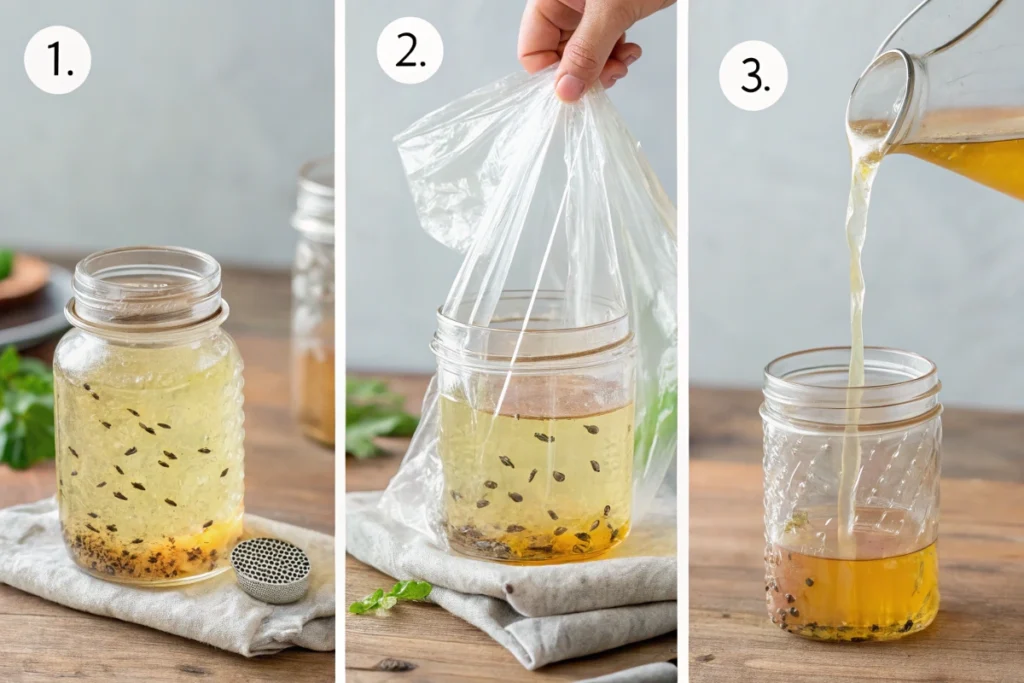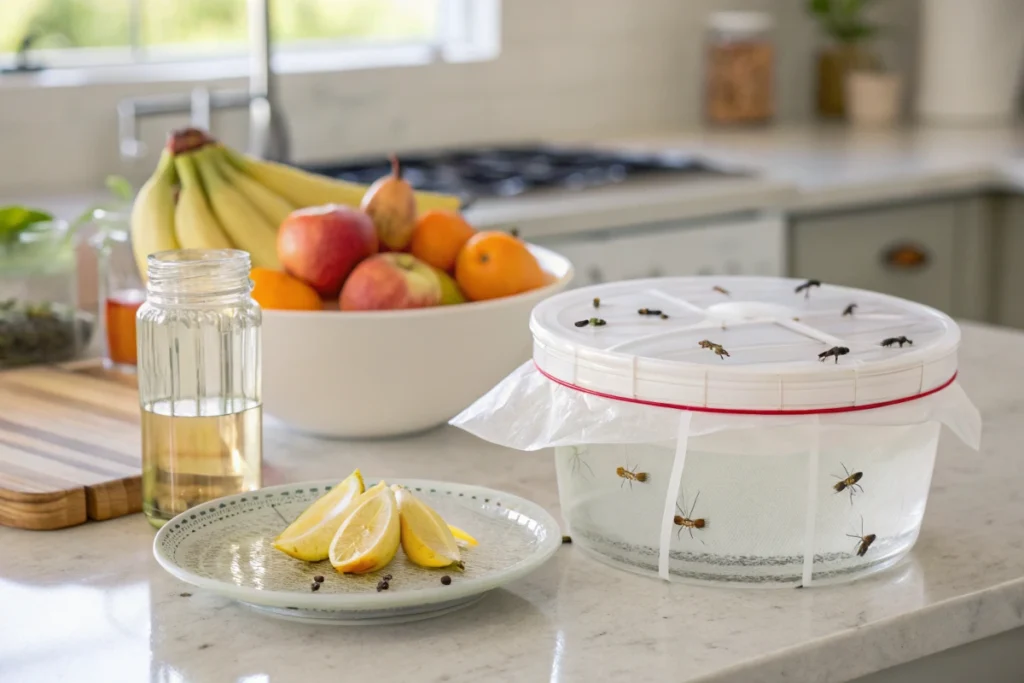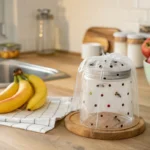Fruit flies, those pesky little invaders, can turn your kitchen into a buzzing nightmare in no time. They seem to appear out of nowhere, hovering around ripe fruits, vegetables, and even your garbage bin. But don’t worry, there’s a simple, budget-friendly solution sitting right in your pantry: white vinegar.
If you’ve ever wondered whether you can make a fruit fly trap with white vinegar, the answer is a resounding yes! This article dives deep into how and why white vinegar works to trap fruit flies, along with easy DIY methods, comparisons with other vinegar types, and best practices to keep these tiny pests away for good.
You’ll also get expert tips on troubleshooting ineffective traps and preventing infestations before they start. So, let’s jump right in and take back your kitchen!
Understanding the Fruit Fly Problem
What Are Fruit Flies and Why Are They a Nuisance?
Fruit flies (Drosophila melanogaster) are tiny, reddish-brown insects that thrive in warm, humid environments, especially where fermenting food is present. They’re drawn to the scent of ripening or rotting fruits, vegetables, and sugary liquids. Despite their short lifespan, they reproduce at an alarming rate, with a single female laying up to 500 eggs in her lifetime.
What makes them particularly frustrating is their ability to sneak into your home through open windows, doors, and even grocery bags. Once inside, they multiply quickly, making it tough to get rid of them.
Common Causes of Fruit Fly Infestations
If you’re dealing with a fruit fly invasion, it’s likely due to one (or more) of these factors:
- Overripe or rotting fruits and vegetables left out in the open
- Dirty drains and garbage disposals filled with food residue
- Sticky spills from juices, sodas, or alcoholic drinks that weren’t cleaned properly
- Trash bins with uncovered food waste
- Damp dish sponges and rags that attract moisture-loving fruit flies
Why Traditional Methods May Not Work
Sure, you can try swatting fruit flies, but their small size and quick movements make them hard to catch. Chemical sprays? Not ideal for a kitchen setting where you prepare food. Even store-bought traps can be hit-or-miss. That’s where a DIY fruit fly trap with white vinegar comes in, it’s cheap, non-toxic, and surprisingly effective at luring these pests into a one-way trip to doom.

Why White Vinegar Works as a Fruit Fly Trap
The Science Behind Vinegar’s Attraction for Fruit Flies
Ever wondered why fruit flies can’t resist vinegar? It all comes down to the fermentation process. As fruits break down, they release a mix of ethanol and acetic acid, the very same compounds found in vinegar. This scent mimics the natural aroma of rotting fruit, tricking fruit flies into thinking they’ve found their next meal.
Once they get close to the fruit fly trap with white vinegar, they’re drawn in by the strong, acidic smell. But here’s the catch: when you mix in a few drops of dish soap, the surface tension of the liquid is broken. Instead of landing and escaping, the flies sink straight into the vinegar and drown.
White Vinegar vs. Apple Cider Vinegar: Which Is Better?
Most DIY fruit fly traps use apple cider vinegar, but can white vinegar do the job just as well? The answer is yes, with a few tweaks.
- Apple cider vinegar has a stronger fruity scent, making it slightly more attractive to fruit flies.
- White vinegar is milder, but adding a small amount of sugar or fruit juice can enhance its effectiveness.
- White vinegar is cheaper and more widely available, making it a budget-friendly option.
- Both types of vinegar work, but if you’re out of apple cider vinegar, white vinegar is a solid alternative.
Additional Household Ingredients That Enhance Effectiveness
Want to boost the power of your vinegar trap? Try these simple add-ons:
- Dish soap: Breaks surface tension, ensuring flies sink and drown.
- Sugar or honey: Increases the sweetness, making the trap even more irresistible.
- Fruit juice or wine: Mimics the scent of fermenting fruit.
DIY White Vinegar Fruit Fly Trap Methods
Method 1: Classic Vinegar and Dish Soap Trap
This is the simplest and most effective method for catching fruit flies.
What You Need:
- ¼ cup of white vinegar
- 3-4 drops of dish soap
- A small glass or jar
How to Make It:
- Pour the white vinegar into a glass or small bowl.
- Add a few drops of dish soap and swirl gently.
- Leave the trap near areas where fruit flies gather.
💡 Why it Works: The scent of vinegar lures the flies in, while the dish soap prevents them from escaping.
Method 2: Vinegar and Plastic Wrap Trap
This method works well for catching a large number of fruit flies.
What You Need:
- A small cup or jar
- ¼ cup of white vinegar
- Plastic wrap
- A rubber band
- A toothpick
How to Make It:
- Pour white vinegar into a cup or jar.
- Cover the opening with plastic wrap and secure it with a rubber band.
- Poke a few small holes with a toothpick.
- Place the trap near your kitchen sink or fruit bowl.
💡 Why it Works: The flies crawl in but can’t find their way out.
Method 3: Vinegar and Paper Funnel Trap
Perfect for when you want a quick, disposable trap.
What You Need:
- A jar
- ¼ cup of white vinegar
- A piece of paper
- Tape
How to Make It:
- Pour white vinegar into a jar.
- Roll a piece of paper into a cone shape, leaving a small hole at the tip.
- Tape the paper in place so it sits snugly in the jar opening.
- Leave the trap in a high-traffic fruit fly area.
💡 Why it Works: Flies enter through the funnel but struggle to get back out.
Comparing White Vinegar with Other DIY Fruit Fly Traps
Apple Cider Vinegar vs. White Vinegar: Which One Works Better?
When it comes to choosing between apple cider vinegar and white vinegar for a fruit fly trap, both have their pros and cons. While apple cider vinegar has a naturally sweet and fermented aroma that fruit flies find irresistible, white vinegar can still be effective, especially when paired with other attractants like sugar or fruit juice.
If you already have white vinegar at home, there’s no need to rush out and buy apple cider vinegar. Simply enhance the scent by adding a little overripe fruit or a spoonful of honey. This boosts the effectiveness of your fruit fly trap with white vinegar without any extra cost.
Balsamic Vinegar as an Alternative Option
Some DIYers swear by balsamic vinegar as an alternative to apple cider or white vinegar. Its rich, fermented smell makes it highly attractive to fruit flies. However, it’s typically more expensive and stickier than other vinegar options, making it a less practical choice.
Other Non-Vinegar-Based DIY Traps
If you’re looking for other natural ways to trap fruit flies, consider these alternatives:
- Wine or Beer Traps – The yeasty, fermented aroma lures fruit flies in, much like vinegar does.
- Rotting Banana or Fruit Traps – Placing overripe fruit in a covered container with holes allows flies in but prevents them from escaping.
- Yeast and Sugar Traps – A mixture of yeast, warm water, and sugar releases carbon dioxide, attracting fruit flies.
No matter which method you choose, the key is to be patient and persistent. If one trap doesn’t seem to be working, try adjusting the placement or switching to a different method.
📌 Looking for more DIY fruit fly solutions? Check out this guide on Homemade Fruit Fly Traps Without Apple Cider Vinegar for alternative methods!
Best Practices for Preventing Fruit Fly Infestations
Proper Kitchen Hygiene to Deter Fruit Flies
Prevention is always better than dealing with an infestation. To keep fruit flies away, make sure to:
✔️ Regularly clean your sink and drains to remove food buildup.
✔️ Take out the trash frequently, especially if it contains food scraps.
✔️ Wipe down counters and tables to eliminate sticky residues.
How to Store Fruits and Vegetables to Minimize Attraction
Fruit flies are drawn to ripening fruits, so how you store them matters. Try these tips:
- Keep ripe fruits in the fridge to slow down fermentation.
- Store produce in sealed containers or mesh produce bags.
- Use a fruit cover to block flies from accessing food.
The Role of Drains and Trash Bins in Fruit Fly Control
Fruit flies often breed in hidden areas like sink drains and trash bins. To prevent this:
- Pour boiling white vinegar down the drain once a week to kill eggs and larvae.
- Clean trash cans regularly and use bags with secure seals.
Troubleshooting Common Issues with Vinegar Traps
What to Do If Your Trap Isn’t Catching Flies
If your fruit fly trap with white vinegar isn’t working, don’t panic! A few small tweaks can make all the difference:
- Use a stronger attractant – White vinegar is effective, but adding a teaspoon of sugar, honey, or fruit juice can make it even more tempting.
- Change the vinegar regularly – Vinegar loses its potency after a day or two, so refresh the mixture every 24–48 hours.
- Move the trap to a high-traffic area – Place your trap near fruit bowls, garbage bins, or sinks where fruit flies tend to gather.
- Use a smaller container – A narrow opening concentrates the scent, making it easier to lure flies in.
How Often to Replace the Vinegar Solution
A good rule of thumb is to replace the vinegar every two days. Over time, dead flies can accumulate, making the trap less effective. Emptying and refilling the trap ensures that the scent stays strong and continues attracting fruit flies.
Why You Should Avoid Strong-Smelling Cleaning Agents Nearby
Fruit flies rely heavily on their sense of smell. If you’re using citrus-scented sprays or bleach near your traps, it might be masking the vinegar’s scent. Try placing traps in an area free of strong chemical odors for the best results.
FAQs – Answering Common Questions About White Vinegar Fruit Fly Traps
Can I Use Distilled White Vinegar Instead of Apple Cider Vinegar?
Yes! While apple cider vinegar has a stronger scent, distilled white vinegar still works, especially if you enhance it with sugar or fruit juice.
How Long Does It Take for a Vinegar Trap to Work?
You should start seeing results within a few hours. However, for a full infestation, leave the traps out for at least 24–48 hours.
Is White Vinegar Safe to Use Around Pets and Children?
Absolutely! White vinegar is a natural, non-toxic substance, making it safe to use in households with pets and kids. Just keep the trap out of reach to avoid spills.
Do Fruit Flies Eventually Die Off on Their Own?
Not really. As long as there’s a food source, they’ll keep reproducing. Without intervention, an infestation can last for weeks.
Will Vinegar Attract Other Insects Into My Home?
No, vinegar primarily attracts fruit flies. However, if you leave overripe fruit or sugary spills unattended, other pests like ants may also take an interest.
Expert Tips for Maximizing Your Vinegar Fruit Fly Traps
How to Make Your Trap Work Faster
If you’re dealing with a serious infestation, you might need to speed up your results. Here’s how:
- Use warm vinegar – Heating white vinegar slightly before adding it to the trap releases a stronger scent, attracting fruit flies faster.
- Increase the number of traps – One trap might not be enough. Place multiple traps in different hotspots like near your trash can, fruit bowl, and sink.
- Combine attractants – Adding a piece of overripe fruit to the vinegar boosts its appeal. The stronger the smell, the more fruit flies you’ll catch.
Best Placement for Maximum Effectiveness
The location of your fruit fly trap with white vinegar plays a huge role in how effective it is. Here are the best places to set your traps:
✔️ Near fruit bowls and countertops where flies are gathering.
✔️ Next to the sink or drain, where flies might be breeding.
✔️ Close to trash bins, especially if they contain food scraps.
✔️ Near recycling bins if they hold empty bottles or cans with sugary residue.
Avoid placing traps near strong-smelling cleaning agents, open windows, or fans, as these can dilute the vinegar scent and reduce effectiveness.
Final Thoughts – Why White Vinegar is the Best Budget-Friendly Solution
Why White Vinegar is a Cost-Effective Fruit Fly Solution
While store-bought traps and pest control methods can be expensive, a fruit fly trap with white vinegar is one of the cheapest and most effective solutions. A single bottle of vinegar costs just a few dollars and can be used to create multiple traps, making it a budget-friendly way to eliminate fruit flies without harmful chemicals.
Compared to other options, white vinegar is:
✅ Affordable – Cheaper than commercial fruit fly traps.
✅ Non-toxic – Safe for use in homes with kids and pets.
✅ Readily available – Found in almost every household.
✅ Easy to use – No special skills or tools required.
Eliminate Fruit Flies for Good
If you’re tired of these tiny invaders taking over your kitchen, it’s time to take action. A DIY fruit fly trap with white vinegar is simple, effective, and chemical-free, giving you a safe and hassle-free way to reclaim your space.
By following the step-by-step methods in this guide, tweaking your approach when needed, and keeping your kitchen clean, you can say goodbye to fruit flies once and for all! 🚀



